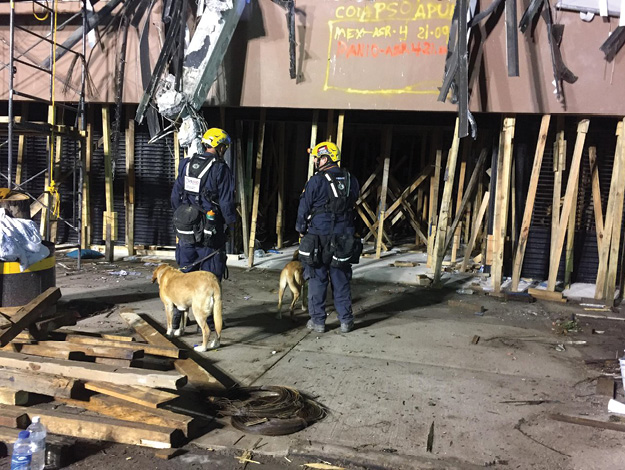
By Larry Collins
The year 2017 was an epic one of disaster responses for California’s fire and rescue resources, including the following: unprecedented numbers of deployments of Federal Emergency Management Agency (FEMA) Urban Search & Rescue (US&R) Task Forces and California Governor’s Office of Emergency Services (Cal OES) Swiftwater/Flood Search & Rescue Teams to hurricane disasters and California flood events that swamped cities and threatened failure of the emergency spillway of the nation’s tallest dam; the Mexico City earthquake disaster; and a wind-driven fire in October that included 21 major wildfires that challenged the state’s mutual-aid system and resulted in the worst destruction and loss of life in the history of California, necessitating the deployment of firefighters from 10 other states and international assistance from as far away as Australia.
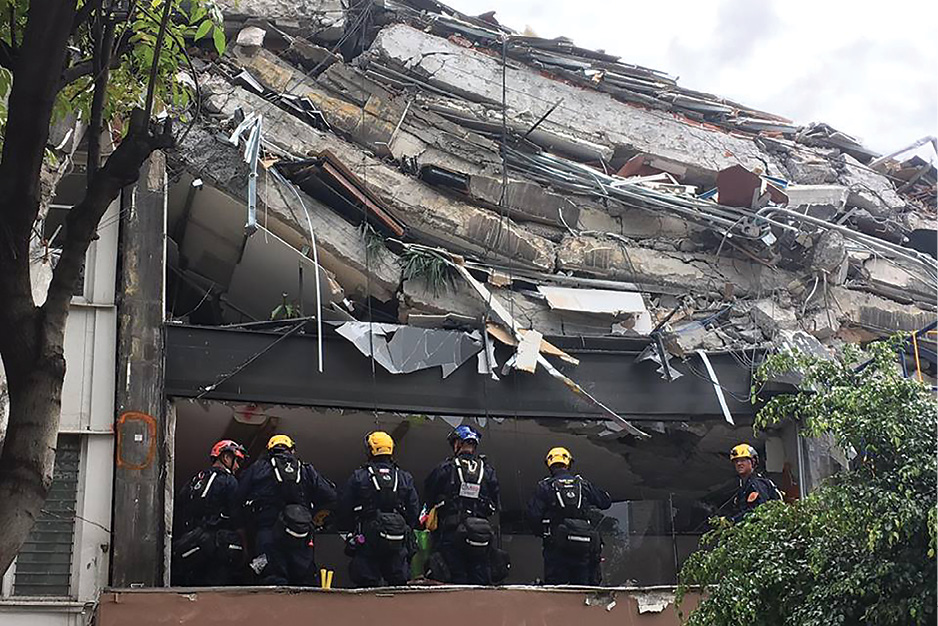
(1) L.A. County firefighters assigned to USA-2 (United States US&R Team 2) beginning search operations at a partial pancake collapse near Mexico City. (Photo courtesy of the L.A. County Fire Department.)
These California-based teams conducted hundreds of live rescues collectively, in cooperation with the other state/national US&R task forces and with the other state, regional, and local responders. These disasters (and the response to Hurricane Matthew in 2016, which resulted in more than 700 rescues by US&R task forces) definitely proved the effectiveness of the water rescue operations mission capabilities that have been added to the state/national US&R task forces in recent years.
They also demonstrated the efficiency of a new capability of all the state/national US&R task forces: US&R task force “Mission-Ready Packages” that allow for targeted US&R task force capabilities to be deployed to any disaster requiring them. US&R Mission-Ready Packages include canine search, communications, hazardous materials, command, logistics support, medical support, search, structures specialist, and technical rescue. (Source: National US&R Response System Mission-Ready Package Handbook, March 2017, FEMA)

(2) Cal OES Swiftwater/Flood Search & Rescue Team 12 (Long Beach Fire Department) heading to Texas. (Photo courtesy of the Long Beach Fire Department.)
And the disaster siege of 2017 didn’t end there: As of this writing, another series of wind-driven wildfires continues to ravage parts of southern California, burning more than 1,000 homes and commercial buildings, driving hundreds of thousands of people from their homes and neighborhoods, and tragically causing the deaths of at least one firefighter (Cal Fire Engineer Cory Iverson was lost in the Thomas Fire) and one civilian.

(3) Cal OES Swiftwater/Flood Search & Rescue Team 10 (Ventura County Fire Department) launching a motorized inflatable rescue boat for search and rescue operations near Lumberton, Texas. (Photo courtesy of the Ventura County Fire Department.)
As of this writing, the Thomas Fire in Ventura and Santa Barbara counties has become the largest wildfire in California history at more than 273,400 acres. The fire has burned more than 1,000 homes and other buildings. More than 8,400 firefighters are on the fire lines and more are on the way, including firefighters from 10 other states. The firefighting resources committed to this fire as of this writing include 972 engines (most in a five-engine Strike Team configuration, each commanded by a Strike Team leader, typically a battalion chief), 94 water tenders, 77 bulldozers, 164 hand crews, 34 helicopters, and six air tankers. And, all this extreme wildfire activity is hitting California at Christmas time when some other states are already blanketed in snow. The timing is tragic for the many people who have lost homes and businesses. It’s worse for the relatives and friends of the 45 people killed in this fire and in the October fire storms (and those who still are missing). More homes burned on the day of this writing, as howling “sundowner” winds pushed the fire into Montecito and Santa Barbara; another week of Santa Ana winds is predicted in Southern California. After two full weeks of firefighting in extreme wind conditions, the end is not yet in sight.
The state’s fire and rescue mutual-aid system is once again fully engaged, and the State Operations Center at the Cal OES headquarters near Sacramento is buzzing with activity around the clock. By the time this article is printed, there will be untold numbers of additional acres burned.
And then, inevitably, will come the floods, mud and debris flows, and other after-effects of the wildfires, when scorched hillsides and mountains are pelted with rain in the winter and spring. But in 2017, the calendar was marked also with unprecedented California fire and rescue responses to assist in disasters in other states and in other nations.
With that as the backdrop, following is a brief snapshot of the extraordinary pace of deployments of California-based fire and rescue resources that occurred during the hurricane siege of 2017.
Hurricane Harvey, California US&R Task Force Deployments
California US&R Task Force 1 (CA-TF1), Los Angeles City Fire Department–Type I US&R Task Force with 80 personnel
California US&R Task Force 2 (CA-TF2), Los Angeles County Fire Department–Water Rescue Mission Ready US&R Task Force Package with 14 personnel
California US&R Task Force 3 (CA-TF3), Menlo Park Fire Protection District–Water Rescue Mission Ready US&R Task Force Package with 14 personnel
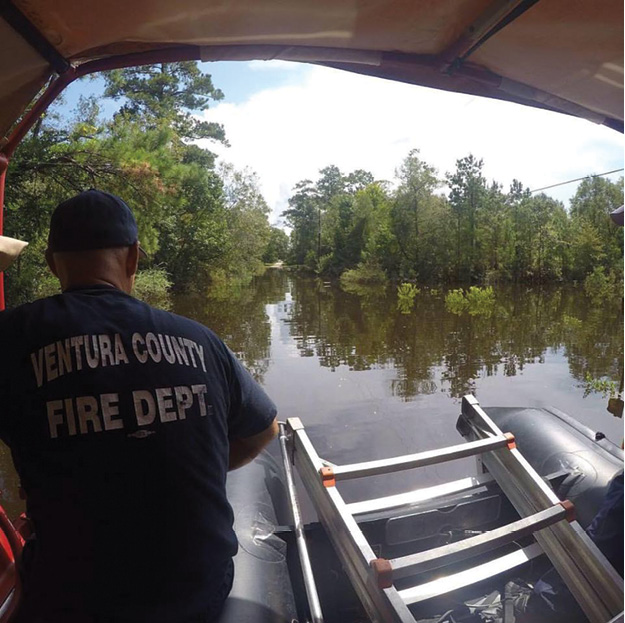
(4) Ventura County firefighters assigned to Cal OES SF-S&R Team 10 preparing to launch for search and rescue in east Texas. (Photo courtesy of the Ventura County Fire Department.)
California US&R Task Force 4 (CA-TF4), Oakland Fire Department–Type I US&R Task Force with 80 personnel
California US&R Task Force 5 (CA-TF5), Orange County Fire Authority–Type III US&R Task Force with 45 personnel
California US&R Task Force 6 (CA-TF6), Riverside City Fire Department–Water Rescue Mission Ready US&R Task Force Package with 14 personnel
California US&R Task Force 7 (CA-TF7), Sac Metro Fire Department–Water Rescue Mission Ready US&R Task Force Package with 14 personnel
California US&R Task Force 8 (CA-TF8), San Diego City Fire Rescue–Type III US&R Task Force with 45 personnel
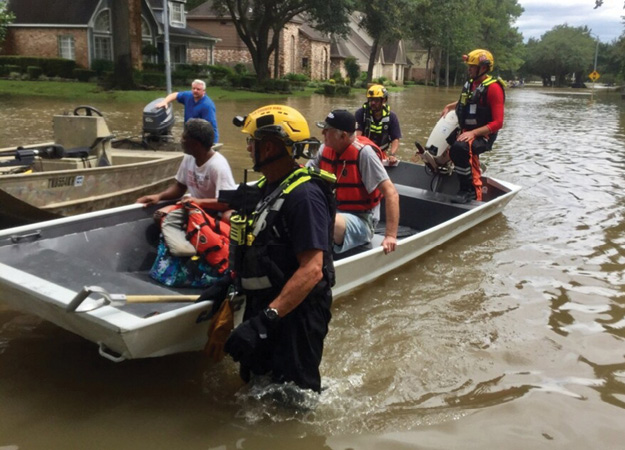
(5) L.A. County firefighters assigned California US&R Task Force 2 conducting waterborne search & rescue operations in Houston. (Photo courtesy of the L.A. County Fire Department.)
30 California-based Overhead Management personnel as a part of the FEMA US&R Incident Support Team to assist them in coordination of US&R operations
Hurricane Harvey, Cal OES Swiftwater/Flood Search & Rescue Team Deployment
Cal OES Swiftwater/Flood Search & Rescue Team 12 (Long Beach Fire Department)
Cal OES Swiftwater/Flood Search & Rescue Team 10 (Ventura County Fire Department)
Hurricane Irma, California US&R Task Force Deployments
CA-TF1 (Los Angeles Fire Department)—Type I US&R Task Force with 80 personnel
CA-TF3 (Menlo Park Fire Department)—Type I US&R Task Force with 80 personnel
CA-TF4 (Oakland Fire Department)—Type I US&R Task Force with 80 personnel
CA-TF8 (San Diego Fire & Rescue Department)—Type I US&R Task Force with 80 personnel
CA-TF6 (Riverside Fire Department)—Canine Mission Ready US&R Task Force Package
20 California-Based FEMA US&R Incident Support Team members
Hurricane Maria, California US&R Task Force Deployments
CA-TF2 as a Type IV US&R Task Force Enhanced with Water Rescue Mission Capabilities
CA-TF6 as a Type IV US&R Task Force Enhanced with Water Rescue Mission Capabilities
CA-TF7 as a Type IV US&R Task Force Enhanced with Water Rescue Mission Capabilities
CA-TF2 (Los Angeles County Fire Department)—Canine Mission Ready US&R Task Force Package
CA-TF7 (Sacramento Fire Department)—Canine Mission Ready US&R Task Force Package
CA-TF1 (Los Angeles Fire Department)—Type I US&R Task Force (Placed on Alert)
CA-TF4 (Oakland Fire Department)—Type I US&R Task Force (Placed on Alert)
30 California-based FEMA US&R Incident Support Team members
Tropical Depression Nate, California US&R Task Force Deployments
3 California-based FEMA US&R Incident Support Team members
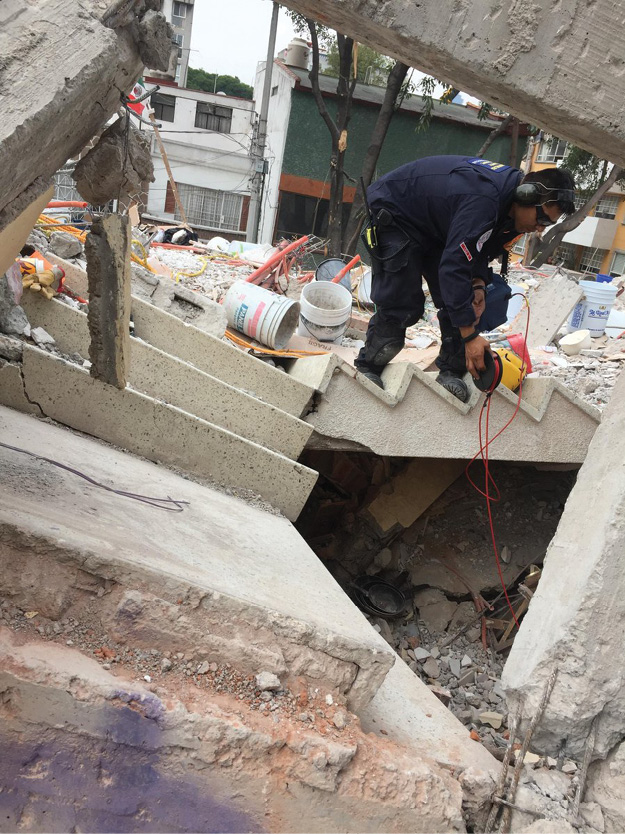
(7) USA-2 members from the L.A. County Fire Department conducting technical search operations at a large collapsed building in Mexico City. (Photo courtesy of the L.A. County Fire Department.)
Mexico City Earthquake, California US&R Task Force Deployment
United States US&R Task Force 2 (USA-2, Los Angeles County Fire Department): “Heavy” International US&R Task Force
Simultaneous October 2017 Wildfire Siege
Number of Major Wildfires in California: 21
Acres Burned: 245,000
Firefighters Assigned to the Wildfires in California: 11,000
California Fire and Rescue Mutual-Aid Resources: 625 California-based engines
Engines Responding from Other States: 213
Number Evacuated: 100,000
Structures Destroyed: 8,900
Fatalities: 43
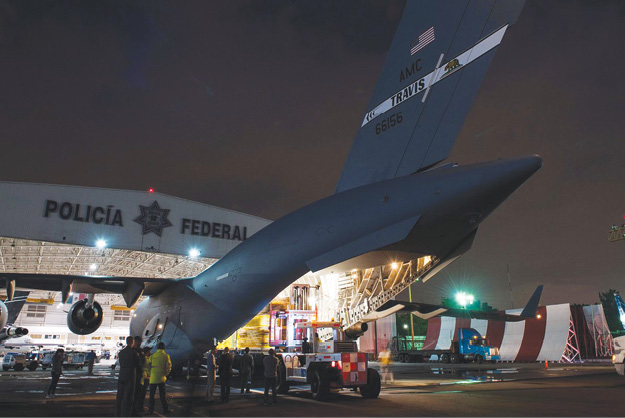
(8) L.A. County firefighters preparing to offload the USA-2 equipment cache after landing in Mexico. (Photo courtesy of the L.A. County Fire Department.)
The responsibility for managing such a wide-ranging and intensely busy statewide mutual-aid system falls to Cal OES, headed by Director Mark Ghilarducci, a longtime fire and rescue operator and chief officer and former deputy chief of Cal OES Special Operations. The Cal OES Operations Section, in the Fire and Rescue Division, led by the state’s Fire & Rescue Chief Kim Zagaris, coordinates the California Fire and Rescue Mutual Aid System, which includes more than 1,000 fire service organizations that have pledged to assist each other with mutual aid through mobilization of shared fire and rescue resources across the state. Coordinated response through the mutual-aid system includes responses to major fires, earthquakes, tsunamis, landslides, floods, mud and debris flows, terrorist attacks, hazardous materials releases, explosions, avalanches, and other disasters that occur in California. It also involves the deployment of California fire and rescue resources to assist other states when requested. The Cal OES Fire & Rescue Ops Section splits the state into North Ops and South Ops, directed by Deputy Chiefs Brain Woodbeck and Art Torres, respectively.
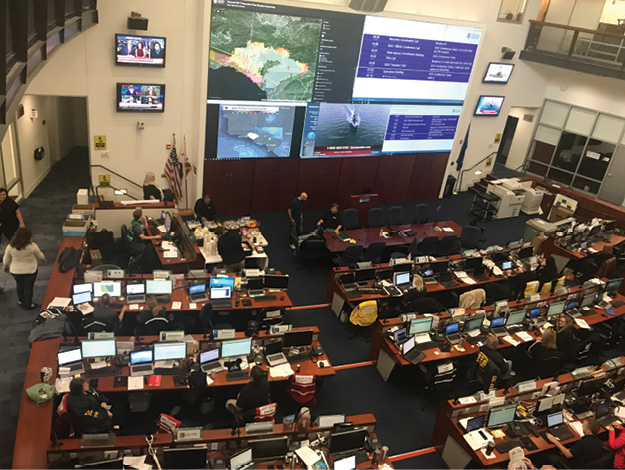
(9) Round-the-clock coordination being provided at the California State Operations Center at Cal OES Headquarters near Sacramento. (Photo by author.)
There are more than 6,000 all-risk fire engines in the California fire and rescue mutual-aid system, including local government fire departments and state agencies like Cal Fire. Cal OES itself maintains its own fleet of 114 Type I fire engines (with 20 more on order), 40 Type III fire engines (with 21 more on order), 12 water tenders, and other fire and rescue resources assigned to local government fire departments across the state, where local firefighters maintain and staff them for mutual-aid response and where their readiness is assessed and assisted by 16 Cal OES assistant chiefs who are strategically deployed around the state to respond to major emergencies and disasters to provide mutual-aid assistance and advice to incident commanders and authorities having jurisdiction. Deputy Chief Steve Hart manages the Cal OES fire and rescue fleet, which also includes 13 Cal OES Swiftwater/Flood Search & Rescue Team vehicles, large incident command support vehicles, and overhead response vehicles and which will soon include 60 Type VI fire engines.
Also within the Fire & Rescue Division, the Cal OES Special Operations and Hazardous Materials Section helps coordinate readiness and response of the eight state/national FEMA US&R task forces and the International “Heavy” or “Medium” US&R Task Force based in California as well as California’s 12 Regional US&R task forces, 65 California FIRESCOPE Type I US&R companies (units that would be known as rescue companies in some other parts of the United States), 32 California FIRESCOPE Type II US&R companies, 54 California FIRESCOPE Type III US&R companies, 114 Cal OES Type I engines that have California FIRESCOPE Type III US&R equipment and capabilities, 19 Cal OES California FIRESCOPE Type II US&R trailers, 13 Cal OES swiftwater/flood search & rescue teams, six California FIRESCOPE Type I swiftwater rescue teams, nine California FIRESCOPE Type II swiftwater rescue teams, two California FIRESCOPE Type III swiftwater rescue teams, 35 California Type I hazmat teams, 35 Type II hazmat teams (12 of which are Cal OES Type II hazmat vehicles being issued to local government fire departments to establish new Type II hazmat teams to operate at local emergencies and when needed for mutual-aid responses across California), and two Type III hazmat teams. This is coordinated by two Cal OES assistant chiefs for US&R and swiftwater-flood and one assistant chief for hazardous materials, with a cadre of hazmat specialists (and a team of environmental scientists who handle regulation of hazardous materials and grants for hazmat training and readiness).
Figure 1. California’s Mutual-Aid System at Work
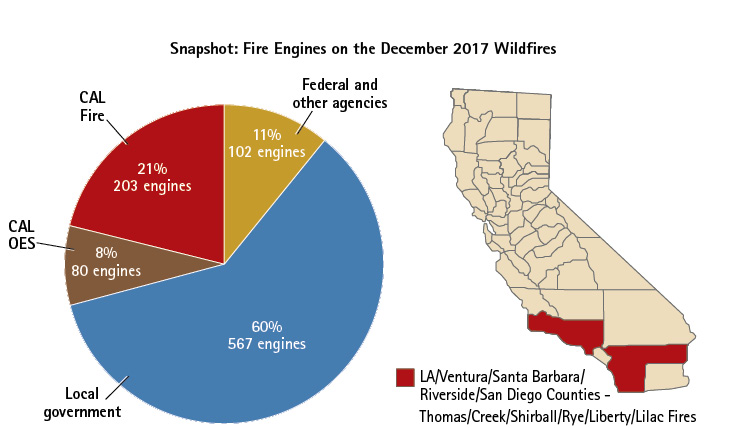
This multi-tiered response system allowed California to effectively provide assistance to other states and nations experiencing a series of deadly hurricane and earthquake disasters while simultaneously managing its own siege of 21 major damaging (and the state’s deadliest and most destructive) wildfires that were ravaging the state.
Larry Collins is deputy chief of the Special Operations & Hazardous Materials Section in the Fire & Rescue Branch of the California Governor’s Office of Emergency Services (Cal OES). Prior to his Cal OES service, he was a 37-year veteran of the Los Angeles County (CA) Fire Department, serving in all ranks including battalion chief, and a US&R Task Force leader and Search Team manager for California US&R Task Force 2 and USA Team 2 (L.A. County FD) since its inception in 1992. He has served on the FEMA US&R Incident Support Team since 1995. From 1992 to 2010, he was a captain on USAR-1 and USAR Task Force 103, responding to technical rescues and multialarm fires across Los Angeles County.
